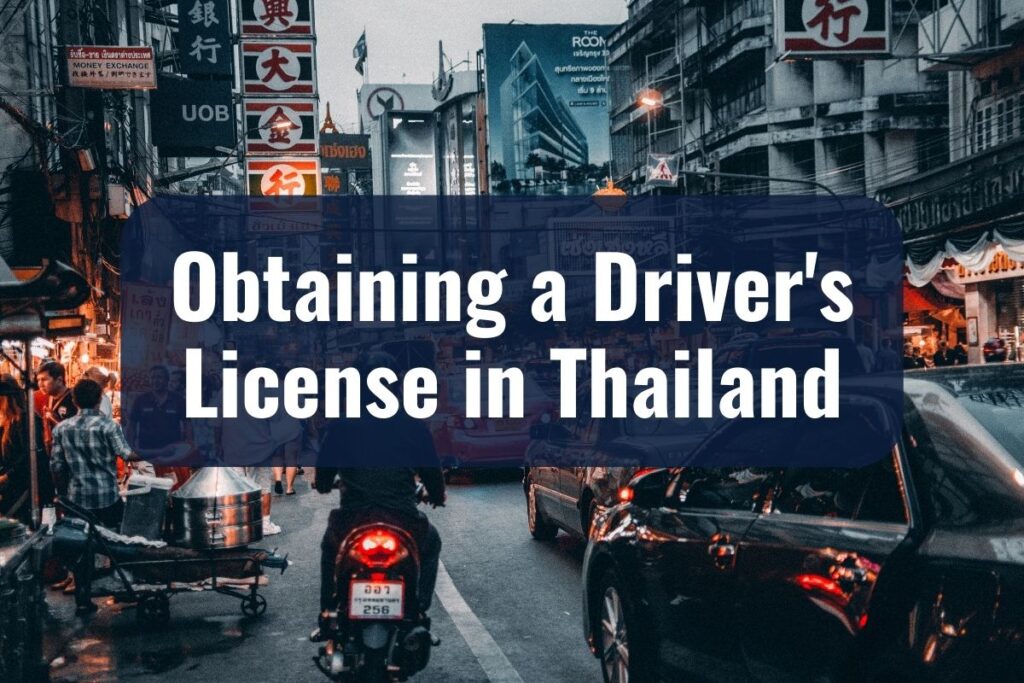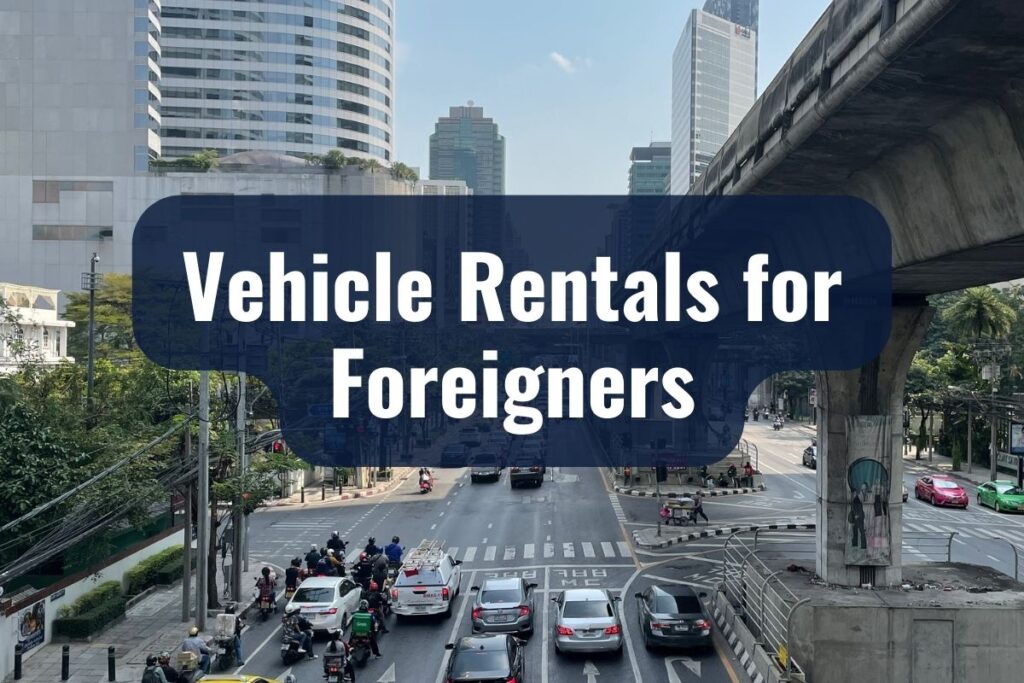Thailand has a distinctive driving culture that sets it apart from many other countries. Whether you’re maneuvering through the bustling streets of Bangkok or navigating the serene countryside, understanding the ins and outs of driving in the Land of Smiles is paramount for every foreigner.
This is a guide on driving in Thailand, from Thai traffic rules to interactions with local traffic police, ensuring that your driving experience in Thailand is enjoyable and safe. So, if you’re gearing up to get behind the wheel in this Southeast Asian nation, let’s dive into the essentials of driving in Thailand.
KEY TAKEAWAYS
- Obtaining a Thai driver’s license involves specific requirements and procedures.
- Parking in Thai cities may vary in availability and cost.
- Thai roads present diverse conditions, from bustling city lanes to rural landscapes.
- Interactions with Thai traffic police are generally straightforward with proper documentation.
- Foreigners can easily rent vehicles but should always ensure proper documentation and insurance.
- Adhering to driving etiquette and safety tips ensures a smoother journey.
- Public transportation, from BTS to tuk-tuks, offers convenient alternatives to driving.
Driving in Thailand: Understanding Thai Traffic Rules
For any foreigner, adapting to a new country’s traffic rules can be a blend of intrigue and caution. Thailand, with its unique blend of tradition and modernity, has a set of traffic regulations that, while sometimes familiar, may also contain nuances that differ from what you might be used to. Ensuring that you’re well-versed with these rules is not only crucial for your safety but also to enjoy a hassle-free driving experience.
The Side of the Road
In Thailand, vehicles drive on the left-hand side of the road. This orientation is particularly important to remember, especially for those coming from countries where driving is on the right.
Speed Limits
Speed regulations vary depending on the type of area and road:
| Location | Speed Limit |
| Cities/Towns | 50 km/h |
| Highways/Rural Roads | 90 km/h |
| Expressways | 120 km/h |
It’s essential to always look out for posted signs as they will indicate if a particular stretch has a different speed limit.
Seatbelt and Helmet Laws
Safety first! In Thailand:
1. All front-seat occupants of a car must wear a seatbelt.
2. Motorbike riders and pillion passengers are legally required to wear helmets at all times. Not only is this a safety measure, but non-compliance can also lead to fines.
Alcohol and Driving Regulations
Thailand has strict laws concerning driving under the influence:
1. The legal blood alcohol limit for regular drivers is 0.05%. For professional and new drivers (those who’ve had their license for less than 2 years), the limit is 0.02%.
2. If you’re caught exceeding this limit, you can face hefty fines, imprisonment, or both. It’s always recommended to opt for alternative transportation if you plan on consuming alcohol.
Obtaining a Driver’s License in Thailand

Here’s a step-by-step guide to help you understand what’s required for foreigners looking to obtain a Thai driver’s license.
Requirements for Foreigners
Before diving into the application process, ensure you meet the following prerequisites:
- Hold a valid passport with a valid non-tourist visa.
- Have proof of residence in Thailand, which can be an official rental agreement, house registration, or an address confirmation from a local immigration office.
- A valid driver’s license from your home country or an international driving permit.
Process of Obtaining a Local Driving License
- Medical Certificate: Before starting your application, obtain a medical certificate from a local clinic or hospital. This document typically certifies that you are free from certain disqualifying health conditions.
- Application Submission: Head to your nearest Department of Land Transport office with the required documentation, including your passport, current driver’s license, medical certificate, and proof of residence.
- Written and Physical Examinations: Applicants will typically undergo a written test (available in English) on Thai road signs and rules. There will also be physical tests to check your reflexes and depth perception. Some provinces may have additional or different testing requirements.
- Practical Driving Test: If you pass the written and physical examinations, you’ll proceed to a practical driving test. This test assesses your actual driving skills on a course.
- License Issuance: If you pass all tests successfully, you will be issued a temporary Thai driver’s license, valid for a year. After the first year, you can apply for a five-year license.
Validity and Renewal of Thai Driving Licenses
Your initial Thai driver’s license is temporary and lasts for one year. After this period, you can apply for the standard five-year license. Renewing your license involves a similar process as the initial application, including a medical check-up and sometimes a refresher course or test on driving laws.
Recognized International Driving Permits in Thailand
If you already possess an International Driving Permit (IDP) from a member country of the 1949 or 1968 Road Traffic Conventions, Thailand recognizes it for up to 90 days. After this duration, it’s recommended to apply for a local license.
Parking in Thailand
In Thailand, while parking might seem straightforward, there are certain nuances that foreigners should be aware of to avoid inconveniences and potential fines. This section sheds light on the ins and outs of parking in the Kingdom of Thailand.
Common Parking Rules and Etiquette
No Parking Zones: Similar to many countries, certain areas are marked as no parking zones. These zones are indicated by either red-and-white or yellow-and-white painted curbs. Parking in these zones can result in fines or your vehicle being towed.
Parking Signs: Always pay attention to posted parking signs. These indicate the parking regulations for a particular stretch of road, including hours when parking might be prohibited.
Parallel Parking: In most Thai cities, parallel parking is the norm. Ensure that your vehicle is appropriately aligned with the road, not obstructing traffic, and is parked in the direction of the flow of traffic.
Parking Payment: In some areas, especially in major cities, you might come across parking attendants who issue tickets. It’s essential to keep this ticket as it indicates your parking time, and you will need it to calculate the fee upon returning.
Differences in Public and Private Parking Spaces
Public Parking: These are usually designated areas managed by the local municipality or an assigned agency. They might be free or require a fee. Always check for signs or ask locals if you’re unsure.
Private Parking Lots: Many shopping malls, hotels, and establishments offer private parking. Some might charge a fee, while others offer free parking for customers. It’s crucial to park only in designated spots to avoid being fined or towed.
Costs and Where to Find Parking in Popular Areas
The cost of parking varies depending on the area:
City Centers: In places like Bangkok, parking in the central districts can range from 20 to 60 THB per hour. It’s always a good idea to check parking rates upon entry.
Tourist Spots: Popular tourist areas might have limited parking or might charge higher rates due to demand. Consider using alternative transportation or parking a bit further away and walking or taking a short ride to your destination.
Residential Areas: While many residential areas offer free street parking, it’s respectful to avoid parking in front of someone’s gate or driveway. In some places, residents might place objects to reserve their regular parking spots. It’s advisable not to move these objects and find another spot.

Driving in Thailand can be a unique experience, given its blend of modern infrastructural developments and traditional road usage habits. Whether you’re cruising through the picturesque landscapes or navigating congested urban streets, being prepared for what lies ahead will ensure a safer and more enjoyable journey. This section will guide you through the characteristics and challenges of Thai roads.
Common Road Signs and Their Meanings
Understanding road signs is fundamental to safe driving. Some signs to be aware of include:
- Stop (ป้ายหยุด): A red octagonal sign with the word “หยุด” (pronounced “yùt”), which means ‘stop’.
- No Entry (ห้ามเข้า): A round sign with a white horizontal line, indicating the road is not accessible.
- Speed Limits (ความเร็ว): Usually a round sign with a number, indicating the maximum speed (in km/h) allowed.
- Beware of Animals (ระวังสัตว์): Often a triangular sign with an image of an animal, warning drivers of potential animal crossings.
Always be on the lookout for signs, as they will guide you safely through different terrains and traffic conditions.
Typical Road Conditions in Cities and Countryside
Urban Roads
In major cities like Bangkok, Chiang Mai, or Phuket, roads are generally well-maintained. However, traffic can be heavy, especially during rush hours. It’s also common to encounter motorcycles weaving through traffic, so always be vigilant.
Rural Roads
Outside urban areas, road conditions can vary. While main roads are typically in good shape, some side roads or paths might be unpaved or filled with potholes. Nighttime driving in rural areas can be particularly challenging due to limited street lighting.
Potential Hazards
- Potholes: Especially after the rainy season, it’s common to find potholes on lesser-maintained roads. Always drive at a speed that allows you to spot and avoid them.
- Animals: In rural areas, be prepared to come across animals like dogs, cows, or chickens on the road. Drive cautiously and give them space to move.
- Unpredictable Behaviors: Thai drivers often have their driving habits. For instance, flashing headlights can mean a driver is coming through rather than giving way. Using indicators might not be as common as in other countries, so always be prepared for sudden lane changes.
- Pedestrian Crossings: Not all pedestrians wait for traffic to stop before crossing. Stay alert, especially near schools or markets.
Interactions with Thai Traffic Police
Interacting with law enforcement in a foreign country can sometimes be a source of anxiety. Understanding the protocols and being prepared can significantly reduce stress and lead to more amicable interactions. Here’s what you need to know when dealing with Thai traffic police.
Common Reasons for Being Stopped
There are several reasons you might be flagged down by the traffic police in Thailand:
Routine Checks: The police often conduct random stops to check for proper documentation.
Traffic Violations: This includes speeding, illegal turns, not wearing a seatbelt or helmet, and other observable offenses.
Checkpoints: Especially during holiday periods or nights, checkpoints are set up to inspect for intoxicated drivers.
What to Do When Stopped
Stay Calm and Respectful: Always pull over safely to the side of the road. Turn off your engine and wait inside your vehicle unless instructed otherwise.
Documentation Ready: Ensure you have your driver’s license, car registration, and passport readily available. If you’re renting a vehicle, also have the rental agreement on hand.
Avoid Arguments: If issued a fine, it’s best not to argue on the spot. If you believe the fine is unwarranted, you can visit the nearest police station for clarification or contestation.
Fines and Penalties
Payment Procedures: If you’re issued a ticket, you’re typically given a period within which to pay the fine at a local police station. Ensure you keep the receipt as proof of payment.
Amount: Fines can vary based on the offense. Minor offenses, like not wearing a helmet, can range from 200 to 500 THB. More serious violations, such as drunk driving, can carry heftier fines and even potential jail time.
Misunderstandings and Communication
Language Barrier: While many Thai police officers in tourist areas speak basic English, it’s not uncommon to encounter some who don’t. Carrying a translation app or a phrasebook can help bridge the communication gap.
Stay Polite: Using the traditional Thai greeting, the “wai” (placing palms together near your chest and bowing slightly), and saying “khrap” (for men) or “kha” (for women) at the end of sentences can show respect and diffuse tensions.
Seeking Assistance: If there’s a serious misunderstanding, consider calling your embassy or consulate for advice or assistance.
Vehicle Rentals for Foreigners

Renting a vehicle, be it a car or a motorcycle, is a popular choice for many foreigners visiting or residing in Thailand. It provides the flexibility to explore at one’s own pace. However, to ensure a hassle-free experience, there are specific considerations and guidelines one should be aware of.
Prerequisites for Renting a Vehicle
Before heading to a rental agency, make sure you meet these basic requirements:
- Valid License: Most rental agencies require an International Driving Permit (IDP) alongside your home country’s driver’s license. Some may accept just the foreign license, but having an IDP is often recommended.
- Age Restrictions: Typically, renters must be between 21 and 70 years old, though this may vary between rental agencies.
- Passport: Your passport will be needed for identification and rental documentation.
Types of Vehicles Available for Rent
Cars
From compact cars to SUVs, rental agencies offer a variety of options. Larger vehicles or luxury cars may have higher rental fees.
Motorcycles and Scooters
These are a popular choice, especially in tourist areas. They offer greater maneuverability in traffic and are cost-effective. However, if you’re unfamiliar with riding, it’s vital to exercise caution.
Bicycles
For short distances or leisurely explorations, some areas also offer bicycle rentals.
Costs and Insurance
Daily Rates: Depending on the type and brand of vehicle, daily rental rates can vary. Generally, motorcycle rentals can start from 150 THB per day, while car rentals might range from 800 THB to several thousand THB per day.
Deposits: Most rental agencies require a deposit, which is refunded upon returning the vehicle without damage.
Insurance: Always inquire about insurance coverage. Some rentals come with basic insurance, but it’s often advisable to opt for full coverage, especially for longer rentals.
Safety and Inspection
Inspect the Vehicle: Before accepting any vehicle, conduct a thorough inspection. Check for existing damages and ensure they’re documented by the agency to avoid disputes during the return.
Safety Gear: If renting a motorcycle or scooter, ensure you’re provided with a helmet. It’s not just a safety measure but also a legal requirement.
Return and Fuel Policy
Fuel Policy: Most rental agencies operate on a ‘full-to-full’ policy, meaning you should return the vehicle with a full tank if that’s how you received it.
Timely Return: Ensure you return the vehicle at the agreed time to avoid additional charges.
Driving Etiquette and Safety Tips
Navigating Thai roads requires a keen understanding of local regulations and an appreciation for the unwritten rules of the road. Being aware of customary driving etiquette and adhering to safety tips can make your driving experience smoother and more enjoyable.
Being Courteous on the Road
- Giving Way: In Thailand, larger vehicles often have the informal right of way. Buses and trucks might merge lanes without much notice. It’s generally safer and more courteous to let them through.
- Horn Usage: While in many countries frequent horn usage can be seen as aggressive or impolite, in Thailand, it’s often used as a polite alert. A short beep can indicate an intention to overtake or just making another driver aware of your presence.
- Overtaking: Always overtake from the right side. Before overtaking, especially on single-lane roads, ensure it’s safe and signal a quick horn beep.
Essential Safety Tips
- Seat Belts and Helmets: Always wear your seatbelt when driving a car. If you’re on a motorcycle or scooter, wearing a helmet is mandatory, not just for the driver but also for the pillion rider.
- Avoid Night Driving: Especially in rural areas, avoid driving after dark. Street lighting might be limited, and hazards like unlit vehicles, animals, or pedestrians become harder to spot.
- Stay Vigilant for Motorcycles: Motorcycles and scooters weave through traffic and might approach from any direction. Always check your mirrors and blind spots.
- Limit Distractions: Using mobile phones without a hands-free system is illegal. It’s always safer to pull over if you need to make a call or check your navigation.
- Follow Speed Limits: Speed limits vary based on the type of road and area. Generally, in cities, it’s 50 km/h, highways are 90 km/h, and motorways can be 120 km/h.
Driving in Adverse Conditions
- Rainy Season Precautions: Roads can become slippery, and visibility might reduce during heavy rains. It’s advisable to reduce speed, turn on headlights, and maintain a safe distance from the vehicle in front.
- Flooding: During intense rainfalls, some roads, especially in low-lying areas, might get flooded. If you’re unsure about the water depth, it’s better to find an alternative route.
Respect for Religious Processions
Occasionally, you might come across religious or traditional processions on the road. These can be temple parades or even funeral processions. It’s a sign of respect to stop and let them pass without interruption.
Public Transportation Alternatives
While driving in Thailand offers a sense of freedom and flexibility, there are times when relying on public transportation might be more convenient or practical. For those moments, it’s good to have a grasp of the varied transportation options Thailand offers, each catering to different needs and preferences.
| Transportation Type | Description | Operating Hours |
| BTS Skytrain | Elevated rapid transit in Bangkok. | Early morning – Midnight |
| MRT Subway | Underground transit connecting core city areas. | Early morning – Midnight |
| City Buses | Extensive bus network covering Bangkok. | Varies by route |
| Metered Taxis | Door-to-door service with fare meters. | 24 hours |
| River Taxis | Boats navigating Bangkok’s waterways. | Varies by route |
| Tuk-Tuks | Iconic three-wheeled vehicles for short distances. | Typically daylight hours |
BTS and MRT in Bangkok
BTS Skytrain
An elevated rapid transit system serving the core areas of Bangkok. The BTS is efficient and ideal for avoiding road traffic, especially during peak hours.
MRT Subway
Another rapid transit option, the MRT serves Bangkok underground. It interconnects with the BTS at certain stations, providing extensive coverage of the city.
Both systems operate from early morning till midnight, offering frequent services. They are equipped with English signs and announcements, making it convenient for non-Thai speakers.
Buses
City Buses
Available in most cities, they’re an economical way to travel. Bangkok’s bus network is expansive but might be a bit daunting for newcomers. Routes are numbered, with some buses being air-conditioned and others not.
Intercity Buses
For longer distances between cities, intercity buses are comfortable and reliable. They range from basic to VIP classes, with the latter offering amenities like larger seats and snacks.
Taxis and Ride-Sharing
Metered Taxis
Available in most urban areas, always ensure the meter is turned on at the start of your journey. Taxis are relatively affordable and are a convenient option for door-to-door travel.
Ride-Sharing
Platforms like Grab operate in many Thai cities, offering car, motorcycle, and even tuk-tuk rides. They provide the added benefit of fare transparency and easy location sharing.
Traditional Thai Transport
Tuk-Tuks
These iconic three-wheeled vehicles are a fun way to get around, especially for short distances. Always agree on a fare before starting your journey.
Songthaews
Translated as “two rows”, these are converted pickup trucks with bench seating in the back. They operate on fixed routes and are a common sight in many Thai towns.
Trains
The State Railway of Thailand operates train services that cover much of the country. While not the fastest mode of transportation, trains offer scenic views, especially on routes like the one to Chiang Mai.
Water Transport
River Taxis
In cities like Bangkok, which are interlaced with canals and rivers, boats offer a unique and often quicker mode of transport, especially during traffic congestion.
Ferries
For island destinations like Koh Samui or Phuket, ferries are a popular choice.


